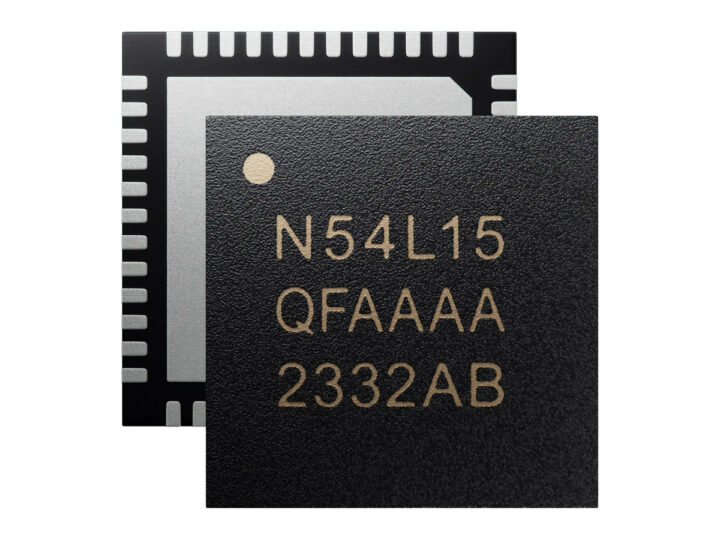Nordic Semiconductor has recently unveiled the 128 MHz nRF54L15 Cortex-M33 multi-protocol wireless microcontroller, the first from the nRF54L Series, and the second from the wider nRF54 family after the more powerful 320 MHz nRF54H20 dual-core Cortex-M33 MCU was introduced last Spring.
While the nRF54H20 was designed to enable new types of IoT devices with a leap in performance and lots of resources with up to 2 MB flash and 1MB SRAM, the new nRF54L15 aims to be an upgrade to the nRF52 series with twice the performance and much better power efficiency, with for instance, half the Rx power consumption over its predecessor.
Nordic Semi nRF54L15 key features and specifications:
- CPU
- Arm Cortex-M33 @ up to 128 MHz with up to 1.5 MB Flash + 256 KB SRAM
- RISC-V coprocessor for “software-defined peripheral”
- Wireless
- Bluetooth 5.4 LE with direction-finding, Bluetooth mesh, etc… Ready for future Bluetooth releases
- 802.15.4 radio for Thread, Matter
- Proprietary 2.4 GHz up to 4 Mbps
- -96 dBm RX sensitivity @ 1 Mbps for Bluetooth LE
- Up to 8 dBm TX power
- New peripherals
- Global RTC
- 14-bit ADC
- Software-defined peripheral
- Security
- Designed for PSA Certified Level 3 IoT security standard
- TrustZone isolation, side-channel protection, and tamper detection
- Power consumption – Rx current consumption is half that of the nRF52840
- Packages – QFN48 (6×6 mm) and WLCSP (2.4×2.2 mm)
- Manufacturing process – TSMC’s 22ULL (22 nm) process technology
The nRF54L15 is designed for high-volume wireless IoT products such as PC accessories, gaming controllers, remote controls, virtual reality and augmented reality devices, Smart Home appliances with Matter support, medical devices, and various industrial IoT applications.
Nordic Semi says the nRF54L15 is available for sampling in the QFN48 package with 31 GPIOs now, but the company also plans to soon launch two ultra-compact WLCSP packages with a 2.4×2.2mm footprint that will be more than 50 % smaller than nRF52840 for designs with strict size constraints. One of the WLCSP packages will offer 32 GPIOs with a 0.3mm pitch, and the other will feature 14 GPIOs with a 0.35mm pitch.
This is an early announcement and the detailed features and specifications have not been released publicly just yet, and people needing more details need to contact their local Nordic sales representative at this time. Eventually, all you need to get started should be made available on the product page, and the press release may also have a few extra tidbits of information.

Jean-Luc started CNX Software in 2010 as a part-time endeavor, before quitting his job as a software engineering manager, and starting to write daily news, and reviews full time later in 2011.
Support CNX Software! Donate via cryptocurrencies, become a Patron on Patreon, or purchase goods on Amazon or Aliexpress







PineTime v2 with two month battery life?
Think that might b Bluetooth only with no 802.15.4 radio or? If it has a 802.15.4 radio then it would also do Zigbee?
On some of the nRF52 chips I think you can’t do Zigbee due to memory limitations rather than lack of radio hardware. A bit surprised you could do Matter in that case though, but I don’t know the details. Or it may be a Zigbee stack licensing issue?
I do believe that Nordic uses a third party proprietary Zigbee stack.
Isn’t Zigbee open source, as opposed to z-wave?
The Zigbee specs are public, but the whole Zigbee stack is quite complex and there are several implementations out there (with various capabilities). Nordic use the Zboss stack which they license. No idea what their license terms are.
Ah ok, thank you for clarifying!
Thread requires an 802.15.4 radio, so it’s probably just a license or resource issue as mentioned by others.
I would expect only the largest version of this chip will be able to run Matter. The ESP32 H2 is very similar and it has been shipping for a couple of years now and it is a lot cheaper. But.. the Nordic one will likely be much more power efficient.
As for Matter, this chip will be limited to implementing basic devices like light bulbs. You need more RAM to do anything more complex. But why use it for a light bulb? H2 is one fourth the price. And there are other Chinese chips which are even cheaper.
The root problem with chips in this Nordic line is that they are $5.
Interesting to know when the Development kit for this chip will appear?